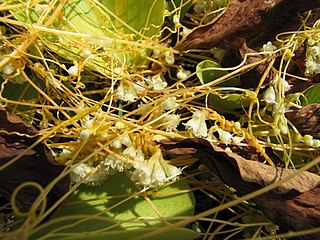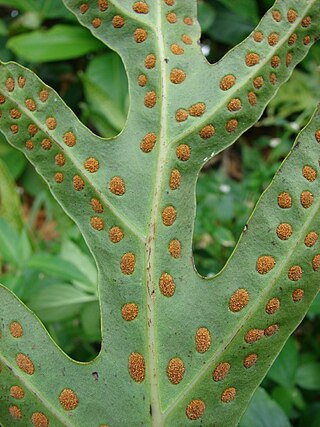
Hula is a Hawaiian dance form expressing chant (oli) or song (mele). It was developed in the Hawaiian Islands by the Native Hawaiians who settled there. The hula dramatizes or portrays the words of the oli or mele in a visual dance form.

A lūʻau is a traditional Hawaiian party or feast that is usually accompanied by entertainment. It often features Native Hawaiian cuisine with foods such as poi, kālua puaʻa, poke, lomi salmon, lomi oio, ʻopihi, and haupia, and is often accompanied with beer and entertainment such as traditional Hawaiian music, kanikapila, and hula. Among people from Hawaiʻi, the concepts of "lūʻau" and "party" are often blended, resulting in graduation lūʻau, wedding lūʻau, baby lūʻau, and birthday lūʻau.

Native Hawaiians are the Indigenous Polynesian people of the Hawaiian Islands.

A lei is a garland or wreath common in The Pacific Islands of Polynesia and also in Asia (Philippines). More loosely defined, a lei is any series of objects strung together with the intent to be worn. Lei of various styles are given as gifts to honour people throughout the Pacific, being presented, for example, to visiting dignitaries, graduates, or to loved ones who are departing.

King Kamehameha I Day on June 11 is a public holiday in the U.S. state of Hawaii. It honors Kamehameha the Great, the monarch who first established the unified Kingdom of Hawaiʻi—comprising the Hawaiian Islands of Niʻihau, Kauaʻi, Oʻahu, Molokaʻi, Lānaʻi, Kahoʻolawe, Maui, and Hawaiʻi. In 1883 a statue of King Kamehameha was dedicated in Honolulu by King David Kalākaua. There are duplicates of this statue in Emancipation Hall at the Capitol Visitor Center in Washington, D.C., and in Hilo, island of Hawaiʻi.

Alyxia stellata, known as maile in Hawaiian, is a species of flowering plant in the dogbane family, Apocynaceae, that is native to Hawaii. It grows as either a twining liana, scandent shrub, or small erect shrub, and is one of the few vines that are endemic to the islands. The leaves are usually ternate, sometimes opposite, and can show both types on the same stem. Flowers are quite inconspicuous and have a sweet and light fragrance of honey. The bark is most fragrant and exudes a slightly sticky, milky sap when punctured, characteristic of the family Apocynaceae. The entire plant contains coumarin, a sweet-smelling compound that is also present in vanilla grass, woodruff and mullein. Fruit are oval and dark purple when ripe. Maile is a morphologically variable plant and the Hawaiian names reflect this.

Davallia is a genus of about 40 species of fern. In the Pteridophyte Phylogeny Group classification of 2016, it is the only genus in the family Davalliaceae, which is placed in the suborder Polypodiineae, order Polypodiales. Alternatively, the family may be placed in a very broadly defined family Polypodiaceae sensu lato as the subfamily Davallioideae.

Sida fallax, known as yellow ilima or golden mallow, is a species of herbaceous flowering plant in the Hibiscus family, Malvaceae, indigenous to the Hawaiian Archipelago and other Pacific Islands. Plants may be erect or prostrate and are found in drier areas in sandy soils, often near the ocean. ʻIlima is the symbol of Laloimehani and is the flower for the islands of Oʻahu, Hawaiʻi, and Abemama, Kiribati.

Cibotium menziesii, the hāpuʻu ʻiʻi or Hawaiian tree fern, is a species of tree fern that is endemic to the islands of Hawaiʻi. It is named after the Scottish naturalist Archibald Menzies. It is also known as the male tree fern, and Cibotium glaucum is deemed the female tree fern due to differences in color.

Pleomele is a former genus of flowering plants. All its species are now placed in the genus Dracaena. The Hawaiian name for plants in this genus is hala pepe, which translates to crushed or dwarfed Pandanus tectorius.

Davallia canariensis, the hare's-foot fern, is a species of fern in the family Davalliaceae. It is endemic to Macaronesia and the Iberian Peninsula. It grows well in a sunny atmosphere and amongst rocks.
Lei Day is a statewide celebration in Hawaii. The celebration begins in the morning of May first every year and continues into the next day. Lei day was established as a holiday in 1929. Each Hawaiian island has a different type of lei for its people to wear in the celebration. The festivities have consistently grown each year and the state of Hawaii has changed the location of the event. Lei day was first held in the Courts and Town Halls but has since been moved to Kapi'olani park.

Native Hawaiian cuisine refers to the traditional Hawaiian foods that predate contact with Europeans and immigration from East and Southeast Asia. The cuisine consisted of a mix of indigenous plants and animals as well as plants and animals introduced by Polynesian voyagers, who became the Native Hawaiians.
Tasmania is home to 'Australia’s largest cool temperate rainforests. Most of Tasmania’s rainforests occur in the North-West and throughout the North East highlands. Cool temperate rainforests typically have a heavy rainfall, cool climate, favor high altitudes and have a limited availability of light.

Cuscuta sandwichiana is a parasitic vine and the only member of the genus Cuscuta that is endemic to the Hawaiian Islands. It parasitizes a wide variety of indigenous, endemic and introduced plants on all of the main Hawaiian islands. It grows in coastal areas with sandy soils from sea level elevation to 975 feet. The indigenous kaunaʻoa pehuCassytha filiformis is a similar-looking species with the same parasitic nature. It is an unrelated plant in the Laurel family Lauraceae which can be distinguished by it larger, coarser yellowish-green stems.

Microsorum scolopendria, synonym Phymatosorus scolopendria, commonly called monarch fern, musk fern, maile-scented fern, breadfruit fern, or wart fern is a species of fern within the family Polypodiaceae. This fern grows in the wild in the Western Pacific rim from Australia to New Caledonia to Fiji and throughout the South Pacific to French Polynesia.

Odontosoria chinensis is a fern in the family Lindsaeaceae. Commonly called lace fern, it is native from India to Hawai'i, and south to Sumatra, Borneo and the Philippines, as well as other parts of the tropics and sub-tropics. It is commonly found in forest openings and disturbed areas such as landslides, along trails or roads. It grows in moist, shady areas from sea level to an elevation of 4,000 feet.

"Auntie" Alice Kuʻuleialohapoʻinaʻole Kanakaoluna Nāmakelua (1892–1987) was a Hawaiian composer and performer. Nāmakelua was also a kumu hula dancer and lei-maker. She was an expert performer of the slack-key guitar and a master of the Hawaiian language. Nāmakelua was a mentor of other musicians and wrote around 180 songs of her own. She was inducted into the Hawaiian Music Hall of Fame in 2011.
Kuana Torres Kahele is an American musician, vocalist, songwriter, record producer, dancer, and educator from Hilo, Hawaii. Known primarily for his original acoustic compositions, Kahele arranges traditional Hawaiian music as well, performing and recording with instruments such as ʻukulele, guitar, ipu, and bass. The majority of his lyrics are written and performed in the Hawaiian language. After learning Kane Hula and Haku Mele in his teens, in 1995 Kahele co-founded Nā Palapalai, a Hawaiian music group that has released a number of albums. Several have charted in the top five on the Billboard Top World Albums chart, and the group has won a large number of Nā Hōkū Hanohano Awards, including Group of the Year.
Nā Palapalai is a Hawaiian music band, originally founded in Hilo, Hawaii. Founded by Kuana Torres Kahele, Kapulanakehau "Kehau" Tamure, and Keao Costa. The group arranges traditional and contemporary Hawaiian music, performing and recording with instruments such as ukulele, guitar, ipu, and upright bass. The majority of the lyrics are written and performed in the Hawaiian language. The group has released a total of eight albums each earning multiple Na Hoku Hanohano Awards, including Group of the Year. Several have charted in the top five on the Billboard Top World Albums chart,
















